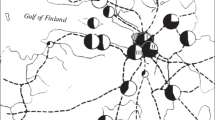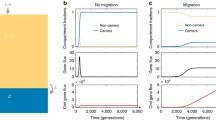Abstract
Genetic ecology is the extension of our modern knowledge in molecular genetics to studies of viability, gene expression and gene movements in natural environments like soils, aquifers and digestive tracts. In such milieux, the horizontal transfer of plasmid-borne genes between phylogenetically distant species has already been found to be much more frequent than had been expected from laboratory experience. For the study of exchanges involving chromosomally-located genes, more has to be learned about the behaviour of transposons in such environments. The results expected from studies in genetic ecology are relevant for considerations of evolution, biodiversity and biosafety. The role of this new field of research in restoring popular confidence in science and in its biotechnological applications is stressed.
Similar content being viewed by others
Literatur
Altmann, M., ed., Gene technology and biodiversity (Multiauthor Review). Experientia49 (1993) 187–234.
Arber, W., Naas, T., and Blot, M., Generation of genetic diversity by DNA rearrangements in resting bacteria. FEMS, Microbiol. Ecol. (1994) in press.
Bartsch, D., Sukopp, H., and Sukopp, U., Introduction of plants with special regard to cultigens running wild, in: Transgenic Organisms: Risk Assessment of Deliberate Release, pp. 135–152. Eds, K. Wöhrmann and J. Tomiuk. Birkhäuser Verlag, Basel 1993.
Bauda, P., Biosafety of GEM release in the environment: The case of GEM tests. Biopractice1 (1992) 12–67.
Beachy, R. N., Powell Abel, P., Nelson, R. S., Register, J., Tumer, N., and Fraley, R. T., Genetic engineering of plants for protection against virus diseases, in: Plant Resistance to Viruses, pp. 151–169. Eds, D. Everett and S. Harnett. John Wiley & Sons, Chichester 1987.
Belongia, E. A., Hedberg, C. W., Gleich, G. J., White, K. E., Mayeno, A. N., Loegering, D. A., Dunnette, S. L., Pirie, P. L., MacDonald, K. L., and Osterholm, M. T., An investigation of the cause of the eosinophilia-myalgia syndrome associated with tryptophan use. New Engl. J. Med.323 (1990) 357–365.
Bertram, J., Strätz, M., and Dürre, P., Natural transfer of conjugative transposon Tn916 between gram-positive and gram-negative bacteria. J. Bact.173 (1991) 443–448.
Blot, M., Meyer, J., and Arber, W., Bleomycin resistance gene derived from the transposon Tn5 confers selective advantage toEscherichia coli K-12. Proc. natl Acad. Sci. USA88 (1991) 9112–9116.
Boller, T., and Wiemken, A., Structure, function and ecology of the mycorrhizal symbiosis. Experientia47 (1991) 311–394.
Bouma, J. E., and Lenski, R. E., Evolution of a bacteria/plasmid association. Nature335 (1988) 351–352.
Brown, L. R., Flavin, C., and Postel, S., Saving the Planet —How to Shape an Environmentally Sustainable Global Economy. W. W. Norton & Company, New York 1991.
Casper, R., and Landsmann, J., The Biosafety Results of Field Tests of Genetically Modified Plants and Microorganisms. Biologische Bundesanstalt für Land- und Forstwirtschaft, Braunschweig (Germany) 1992.
Dixon, R., Genetic regulation of nitrogen fixation, in: The Nitrogen and Sulphur Cycles, pp. 417–438. Eds J. A. Cole and S. Ferguson. Cambridge University Press, Cambridge 1988.
Dixon, R. O. D., and Wheeler, C. T., Nitrogen Fixation in Plants. Chapman and Hall, New York 1986.
Duval-Iflah, Y., Raibaud, P., and Rousseau, M., Antagonism among isogenic strains ofEscherichia coli in the digestive tracts of gnotobiotic mice. Infect. Immun.34 (1981) 957–969.
Duval-Iflah, Y., Raibaud, P., Tancrède, C., and Rousseau, M., R-plasmid transfer fromSerratia liquefaciens toEscherichia coli in vitro and in vivo in the digestive tract of gnotobiotic mice associated with human fecal flora. Infect. Immun.28 (1980) 981–990.
Edlin, G., Lin, L., and Bitner, R., Reproductive fitness of P1, P2 and Mu lysogens. J. Virol.21 (1977) 560–564.
Edlin, G., Tait, R. C., and Rodriguez, R. L., A bacteriophage λ cohesive ends (cos) DNA fragment enhances the fitness of plasmid-containing bacteria growing in energy-limited chemostats. Bio/Technology2 (1984) 251–254.
Farinelli, L., Malnoë, P., and Collet, G. F., Heterologous encapsidation of potato virus Y strain O (PVYo) with transgenic coat protein of PVY strain N (PVYn) inSolanum tuberosum cv Bintje. Bio/Technology10 (1992) 1020–1025.
Foster, P., and Cairns, J., Mechanisms of directed mutation. Genetics131 (1992) 783–789.
Fry, J. C., and Day, M. J., Bacterial Genetics in Natural Environments. Chapman and Hall, London 1990.
Gauthier, M., and Breittmeyer, V. A., Gene transfer in marine environments, in: Bacterial Genetics in Natural Environments, pp. 100–110. Eds J. C. Fry and M. J. Day. Chapman and Hall, London 1990.
Hahn, D., Amann, R. J., Ludwig, W., Akkermans, A. D., and Schleifer, K. H., Detection of micro-organisms in soil after in situ hybridization with rRNA-targeted, fluorescently labelled oligonucleotides. J. gen. Microbiol.138 (1992) 879–887.
Hall, B. G., Is the occurrence of some spontaneous mutations directed by environmental challenges? The New Biologist3 (1991) 719–733.
Hall, B. G., Selection-induced mutations occur in yeast. Proc. natl Acad. Sci. USA86 (1992) 2775–2778.
Hartl, D. L., Dykuhizen, D. E., Miller, R. D., Green, L., and deFramond, J., Transposable element IS50 improves growth rate ofEscherichia coli cells without transposition. Cell35 (1983) 503–510.
Heitmann, D., Hackula, G., Kopecka, H., and Lopez-Gila, J. M., Spontane Genübertragung von Bakterien auf Säugetier-Zellen, in: Biologische Sicherheit, pp. 251–266. Ed. E. Weber. Forschungszentrum Jülich GmbH. Postfach 1913, D-5170 Jülich 1990.
Higgins, N. P., Death and transfiguration among bacteria. TIBS17 (1992) 207–211.
Hofmann, K. H., and Schweder, T.,Escherichia coli host/plasmid systems providing biological containment, in: Transgenic Organisms: Risk Assessment of Deliberate Release, pp. 193–208. Eds K. Wöhrmann and J. Tomiuk. Birkhäuser Verlag, Basel 1993.
Hurek, T., Reinhold-Hurek, B., Van Montagu, M., and Kellenberger, E., Infection of intact roots of Kallar grass and rice seedlings byAzoarcus. Nitrogen fixation. Proceedings of the 5th Int. Symp. on nitrogen fixation with non-legumes, pp. 235–242. Eds M. Polsinelli, R. Materassi and M. Vincenzini. Kluwer Academic Publishers, Dordrecht, 1990.
Hussain, M., Wilcox, M. H., and White, P. J., The slime of coagulase-negativeStaphlococci: Biochemistry and relation to adherence. FEMS Microbiol. Rev.104 (1993) 191–208.
Johnston, H. W. B., Firmin, J. L., and Rossen, L., On the analysis of symbiotic genes of Rhizobium, in: The Nitrogen and Sulphur Cycles, pp. 439–455. Eds, J. A. Cole and S. Ferguson. Cambridge University Press, Cambridge 1988.
Kellenberger, E., Gentechnik: Fortschritt oder Bedrohung? Bulletin der Vereinigung der schweiz. Hochschuldozenten17 (1991) 4–14.
Kellenberger, G., and Kellenberger, E., Etude de souches colicinogènes au microscope électronique. Schweiz. Z. allg. Path. Bakt.19 (1956) 582–597.
Kessler, D. A., Taylor, M. R., Maryansky, J. H., Flamm, E. L., and Kahl, L. S., The safety of foods developed by biotechnology. Science256 (1992) 1747–1749.
Klijn, N., Weerkamp, A. H., and de Vos, W., Identification of mesophilic lactic acid bacteria using polymerase chain reaction-amplified variable regions of 16S rRNA and specific DNA-probes. Appl. envir. Microbiol.57 (1991) 3390–3393.
Kowarik, I., Einführung und Ausbreitung nichteinheimischer Gehölzarten in Berlin und Brandenburg und ihre Folgen für Flora und Vegetation. Ein Modell für die Freisetzung gentechnisch veränderter Organismen. Verh. Bot. Ver. Berlin BrandenburgBeiheft 3 (1992).
Laville, J., Voisard, C., Keel, C., Maurhofer, M., Defago, G., and Haas, D., Global control in Pseudomonas fluorescens mediating antibiotic synthesis and suppression of black root rot of tobacco. Proc. natl Acad Sci. USA89 (1992) 1562–1566.
Lea, D. E., Actions of Radiations on Living Cells. University Press, Cambridge, McMillan Comp., New York 1947.
Lin, L. R., Bitner, R., and Edlin, G., Increased reproductive fitness ofEscherichia coli lambda lysogens. J. Virol.21 (1977) 554–559.
Lohmeyer, W., and Sukopp, H., Agriophyten in der Vegetation Mitteleuropas. Schr Reihe Vegetationskde25 (1992) 1–188.
Lorenz, M. G., and Wackernagel, W., Natural genetic transformation ofPseudomonas stutzeri by sand-adsorbed DNA. Archs Microbiol.154 (1990) 380–385.
Lorenz, M. G., and Wackernagel, W., High frequency of natural genetic transformation ofPseudomonas stutzeri in soil extract supplemented with a carbon/energy and phosphorus source. Appl. envir. Microbiol.57 (1991) 1246–1251.
Lorenz, M. G., and Wackernagel, W., Bacterial gene transfer in the environment, in: Transgenic Organisms: Risk Assessment of Deliberate Release, pp. 43–64. Eds K. Wöhrmann and J. Tomiuk. Birkhäuser Verlag, Basel 1993.
Margulis, L., and Tester, R., Symbiosis as a Source of Evolutionary Innovation, Speciation and Morphogenesis. MIT Press, Cambridge, MA, London 1991.
Marshall, B., Schluederberg, S., Tachibana, C., and Levy, S. B., Survival and transfer in the human gut of poorly mobilizable (pBR322) and of transferable plasmids from the same carrierEscherichia coli. Gene14 (1981) 145–154.
Mazodier, P., Petter, R., and Thompson, C., Intergeneric conjugation betweenEscherichia coli andStreptomyces species. J. Bacteriol.171 (1989) 3583–3585.
McCarty, M., The Transforming Principle. W. W. Norton & Comp., New York 1985.
Michel, F., and Dujou, B., Genetic exchanges between bacteriophage T4 and filamentous fungi. Cell46 (1986) 323.
Obrist, W., Archetypen. Walter Verlag, Olten 1990.
Ogunseitan, O. A., Sayler, G. S., and Miller, R. V., Application of DNA probes to analysis of bacteriophage distribution patterns in the environment. Appl. environ. Microbiol.58 (1992) 2046–2052.
Palaccios, R., Mora, J., and Newton, W. E., New Horizons in Nitrogen Fixation. Kluwer Academic Publishers, Dordrecht 1993.
Rehmann-Sutter, C., Gefährlichkeit unbekannter Gefahren. Rekombinante Pflanzen im Freiland? (Kontroverse mit B. Weber und I. Potrykus). Societé suisse d'ethique biomédicale (SSEB), Fondation Jeantet, Geneva. Folia bioethica11 (1992) 1–39.
Romanowski, G., Lorenz, M. G., and Wackernagel, W., Adsorption of plasmid DNA to mineral surfaces and protection against DNase I. Appl. envir. Microbiol.57 (1991) 1057–1061.
Roszak, D. B., and Colwell, R. R., Survival strategies of bacteria in the natural environment. Microbiol. Rev.51 (1987) 365–379.
Roten, D. A., and Karamata, D., Endogenous synthesis of peptido-glycan in eukaryotic cells; a novel concept involving its essential role in cell division, tumor formation and the biological clock. Experientia48 (1992) 921–931.
Salyers, A. A., and Shoemaker, N. B., Insights into gene transfer mechanisms, in: BAGECO 4. Ed. J. D. van Elsas, to appear 1994.
Saye, D. J., Ogunseitan, O. A., Sayler, G. S., and Miller, R. V., Transduction of linked chromosomal genes betweenPseudomonas aeruginosa strains during incubation in situ in a freshwater habitat. Appl. envir. Microbiol.56 (1990) 140–145.
Skinner, F. A., et al. (eds), Nitrogen fixation with nonlegumes. Kluwer Academic Publishers, Dordrecht 1989.
Smalla, K., Isemann, M., and Weege, K.-H., Characterization of microbial emissions from a fermentation plant using a genetically modified bacillus strain, in: The Release of Genetically Modified Microorganisms, pp. 129–131. Eds D. E. S. Stewart-Tull and M. Sussman, Plenum Press, New York 1992.
Smalla, K., Cresswell, N., Mendonca-Hagler, L. C., Wolters, A., and van Elsas, J. D., Rapid DNA extraction protocol from soil for polymerase chain reaction — mediated amplification. J. appl. Bacteriol.74 (1993) 78–85.
Stotzky, G., and Babich, H., Survival of, and genetic transfer by, genetically engineered bacteria in natural environments. Adv. appl. Microbiol.31 (1986) 93–138.
Thakur, M. S., Kennedy, M. J., and Karanth, N. G., An environmental assessment of biotechnological processes. Adv. appl. Microbiol.36 (1991) 67–86.
Timoféeff-Ressovsky, N. W., Zimmer, K. G., and Delbrück, M., Gene mutation and gene structure. Nachr. Ges. Wiss. Göttingen1 (1935) 189.
Timpe, U., Main, E., and Casper, R., Präimmunitätserzeugung durch Uebertragung defekter Virusgenome zur Bekämpfung der Schaskakrankheit der Pflaume, in: Biologische Sicherheit, pp. 213–217. Ed. E. Weber. Forschungszentrum Jülich GmbH. Postfach 1913, D-5170 Jülich 1990.
Trieu-Cuot, P., Carlier, C., Martin, P., and Courvalin, P., Plasmid transfer by conjugation fromEscherichia coli to grampositive bacteria. FEMS Microbiol. Lett.48 (1987) 289–294.
van Elsas, J. D., van Overbeek, L. S., Feldmann, A. M., Dullemans, A. M., and de Leeuw, O., Survival of genetically engineeredpseudomonas fluorescens in soil in competition with the parent strain. FEMS Microbiol. Ecol.85 (1991) 53–64.
von Weizsäcker, E. U., Erdpolitik. Ökologische Realpolitik an der Schwelle zum Jahrhundert der Umwelt. Wissenschaftliche Buchgesellschaft, Darmstadt 1990.
Walker, G. C., Inducible DNA repair systems. A Rev. Biochem.54 (1985) 425–457.
Wöhrmann, K., and Tomiuk, J., Transgenic Organisms; Risk Assessment of Deliberate Release. Birkhäuser, Basel 1993.
Zünd, P., and Lebek, G., Generation time-prolonging R plasmids: Correlation between increases in the generation time ofEscherichia coli caused by R plasmids and their molecular size. Plasmid3 (1980) 65–69.
Author information
Authors and Affiliations
Rights and permissions
About this article
Cite this article
Kellenberger, E. Genetic ecology: A new interdisciplinary science, fundamental for evolution, biodiversity and biosafety evaluations. Experientia 50, 429–437 (1994). https://doi.org/10.1007/BF01920741
Published:
Issue Date:
DOI: https://doi.org/10.1007/BF01920741




